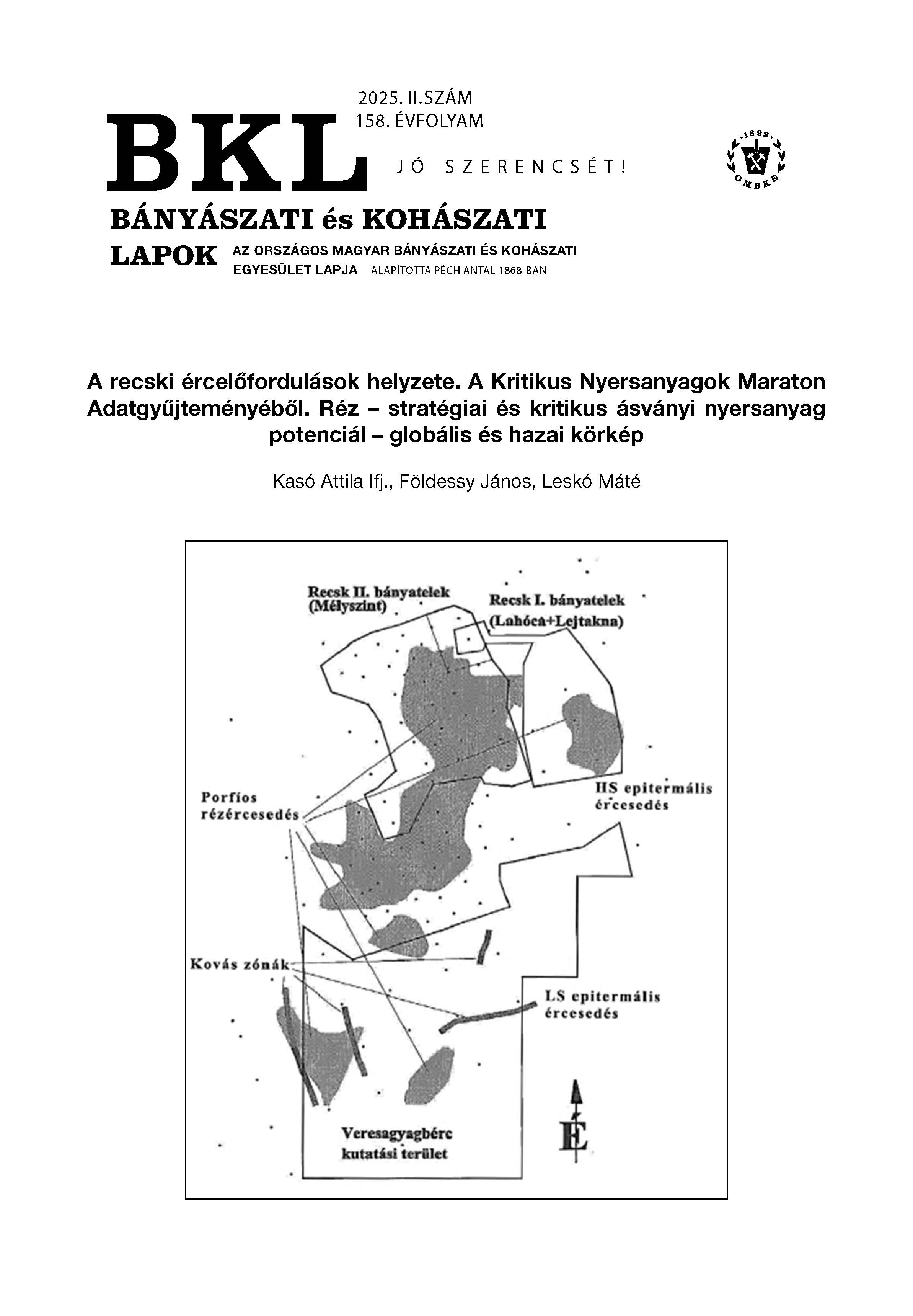From the Critical Raw Materials Marathon Data Collection. Copper – strategic and critical mineral raw material potential – global and domestic overview
Abstract
Copper is one of the most significant strategic mineral resources its market demand continously grows. In our study, a situational picture is provided about the mineral resource occurrences and mining production in the world, Europe and the Carpathian region. We also summarize the knowledge that is publicly known about our domestic, explored and unexplored copper mineralizations. At the end detailed reassessment of our most promising areas and the completion of research is proposed.
References
ECI (2023): Copper – the pathway to net zero. Regional focus Europe. European Copper Institute. https://internationalcopper.org/resource/copper-pathway-tonet-zero/
Gill C. B. (1980): Non-ferrous Extractive Metallurgy. John Wiley & Sons, New York, pp. 29–35.
MINING (2017): https://www.mining.com/web/copper-sx-ew-what-are-the-options/
Dill H. D. (2010): The “chessboard” classification scheme of mineral deposits: Mineralogy and geology from aluminum to zirconium. Earth Science Reviews, 100, 1–420. https://doi.org/10.1016/j.earscirev.2009.10.011
Chavez W. X. Jr. (2021): Weathering of copper deposits and copper mobility: mineralogy, geochemical stratigraphy, and exploration implications. SEG Discovery 126, 16–27. https://doi.org/10.5382/SEGnews.2021-126.fea-01
MININGTECH (2024): https://www.mining-technology.com/marketdata/ten-largest-coppers-mines/?cfview
GLOBAL (2025): https://www.globaldata.com/data-insights/mining/europe-- five-largest-copper-mines-in-2090652/
SCRREEN (2024): https://scrreen.eu/wp-content/uploads/2024/01/SCRREEN2_factsheets_COPPER-update.pdf
ZIJIN (2025): https://www.zijinmining.com/global/program-detail-71737.htm
OÁNY (2023): https://sztfh.hu/downloads/banyaszat/nyilvantartasok/asvanyvagyon-nyilvantartas/magyarorszag_asvanyvagyona_2023.pdf
USGS (2024) Mineral commodity summaries https://pubs.usgs.gov/periodicals/mcs2024/mcs2024.pdf
Földessy J. (szerk., 1997): Lahóca Veresagyagbérc terület. Földtani kutatás zárójelentése. Enargit Kft. Kézirat.
Fekete Zs., Smyth M. (2012): Földtani zárójelentés a „Parád Észak/Dél” kutatási területen 2005–2011 között végzett földtani kutatási tevékenységről. Eastmine Kft. Kézirat.
Turi J. (2012): A recski lejtakna hidrotermás ásványparagenezisének újravizsgálata. Szakdolgozat. ELTE, Budapest.
Takács Á., Molnár F., Turi J., Mogessie A., Menzies J. C. (2017): Ore mineralogy and fluid inclusion constraints on the temporal and spatial evolution of a high-sulfidation epithermal Cu-Au-Ag deposit in the Recsk ore complex, Hungary. Econ. Geol., 112/6, 1461–1481. https://doi.org/10.5382/econgeo.2017.4517
Gagyi-Pálffy A. (1975): A recski mélyszinti ércesedés megismerése, általános jellemzése és népgazdasági jelentősége. Földtani Közlöny, 105, 571–581. https://epa.oszk.hu/01600/01635/00213/pdf/EPA01635_foldtani_kozlony_1975_105_s_571-581.pdf
Földessy J., Szebényi G. (2008): The mineralization of the Recsk Deeps and Lahóca – short geological overview. Publications of the University of Miskolc, Geosciences Series A. Mining. Vol. 73, 85–98. https://matarka.hu/koz/ISSN_1219-008X/73k_2008_eng/ ISSN_1219-008X_vol_73_2008_eng_085-098.pdf
Török K. (szerk., 2016): Recsk II. rézérc koncesszióra javasolt terület komplex érzékenységi és terhelhetőségi vizsgálati jelentése. MBFH. Budapest, Kézirat.
Németh N., Földessy J., Turi J. (2016): Ore geology of the copper sulfide mineralization in the Rudabanya ore bearing complex. Central European Geology, 60, 53–72. https://doi.org/10.1556/24.59.2016.005
Csillagné Teplánszky E., Csongrádi J., Korpás L., Pentelényi L., Vetőné Árkos É. (1983): A Börzsöny-hegység központi területének felépítése és ércesedése. MÁFI Éves Jelentése 1981. évről, pp. 77–127.
Várszegi K. (1965): Karbonátos rézásvány-előfordulás a mecseki Éger-völgy alsótriász rétegeiben. Földtani Közlöny 95, 437–438. https://real-j.mtak.hu/8907/4/Foldtani_Kozlony_1965_95_4.pdf
Várszegi K., Virág K. (1967): Jelentés a Petőcz légakna körüli rézérc kutatásokról. MÉV. Kézirat.
Katona G. (2014): A Rudna (Lengyelország) perm és Mecsek perm-alsó triászPatacsi Formáció rétegkövető ércesedéseinek összehasonlító földtani és geokémiai vizsgálata. Diplomamunka, Miskolci Egyetem.
Böjtösné Varrók K. (1965): A felsőcsatári talk- és szerpentin előfordulás földtani ismertetése és Cr-Ni-Co tartalmának vizsgálata. MÁFI, Budapest.
Kun B. (1989): 25 éves az Országos Érc és Ásványbányák. OÉÁ, Budapest.
Csiffáry G (2009): A lahócai ércbányászat története (1860–1979). 144 p. Ércbányászati Múzeum Alapítvány Rudabánya. https://mek.oszk.hu/07600/07686/07686.pdf
Balla K. (1988): Rudabánya bányabezárási dokumentáció. NME Miskolc. Kézirat.
ORIGO (2024): https://www.origo.hu/gazdasag/2024/ 04/kiderult-mekkora-az-allami-vagyon-erteke
Bačo P., Bačova Z., Nemeth Z., Repčiak M. (2015):5. Potential occurrence of selected, mainly critical raw materials at the territoryof the Slovak Republic in respect to EU countries needs. Slovak Geol. Mag., 15/2, 87–120. https://www.researchgate.net/publication/294886595_5_Potential_Occurrence_of_Selected_Mainly_Critical_Raw_Materials_at_the_Territory_of_the_Slovak_Republic_in_Respect_to_EU_Countries_Needs
Kasó A. ifj. (szerk.): Földtani kutatási zárójelentés a rudabányai barit kutatásról. Rotaqua KFT. Kézirat.



